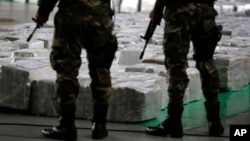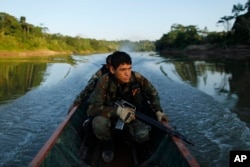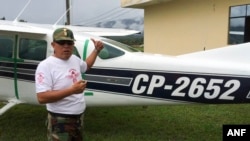It happens about four times a day, right under the nose of Peru's military: A small single-engine plane drops onto a dirt airstrip in the world's No. 1 coca-growing valley, delivers a bundle of cash, picks up more than 300 kilos of cocaine and flies to Bolivia.
Roughly half of Peru's cocaine exports have been ferried eastward to Bolivia on this "air bridge," police say, since the rugged Andean nation became the world's leading producer of the drug in 2012.
Prosecutors, narcotics police, former military officers and current and former U.S. drug agents say that the narco-flight plague is the military's failure because it controls the remote jungle region known as the Apurimac, Ene and Mantaro river valley.
The transactions normally take about 10 minutes: A dozen or so drug-carrying backpackers will appear on a landing strip's fringe as a plane approaches and men with assault rifles keep watch. Money is offloaded and drugs fitted into the cabin.
The motor re-engages. The plane whirs aloft.
An Associated Press investigation found that "narco planes" have touched down just minutes by air from military bases in the nearly road-less region known by its Spanish acronym as the VRAEM.
The AP obtained video of two such transactions taken by drug police who said they were too outgunned to intervene.
The airborne flow — each planeload of cocaine is worth at least $7.2 million overseas — is so brazen that Peru's congress voted unanimously in August to authorize shooting down the mono-engine planes.
But whether the government will act decisively is in question. Earlier this year, it scrapped plans to buy and install the necessary state-of-the-art radar, a $71 million purchase it announced in congress last November.
President Ollanta Humala, a former army lieutenant colonel whose approval rating is below 15 percent, has eight months left in office.
Wilson Barrantes, a retired army general who has long complained about military drug corruption, said giving the armed forces control of the cocaine-producing valley is "like putting four street dogs to guard a plate of beefsteak."
One accused narco-pilot interviewed by the AP said some local military commanders charge $10,000 per flight to let cocaine commerce go unhindered.
Peru's defense and interior ministers did not respond to repeated AP requests to discuss the accusations.
Deputy Defense Minister Ivan Vega, who runs counterinsurgency efforts in the region, said no military officials were under investigation to his knowledge.
"Corruption exists, but we are always looking out for it," he said. "If we know of anyone involved, we'll throw the book at them."
On taking office in 2011, Humala said combatting illicit drugs was a priority. His government has destroyed record amounts of coca leaf.
But that's not enough, said Sonia Medina, the public prosecutor for illicit drugs.
Trafficking and related corruption in the police, military, courts and criminal justice system have gone "from bad to worse" on Humala's watch, she said. "What we are doing in counter-narcotics is completely distorted, incoherent and inert."
Most of Peru's cocaine production has merely shifted to the VRAEM region, where there is no eradication.
The Ireland-sized area has been under a state of emergency for nine years owing to the persistence of drug-running Shining Path rebels. They have slain more than 30 police and soldiers during Humala's tenure but are now much reduced, down to about 60 combatants.
The government has nevertheless resisted destroying coca in the region, saying it would cause a bloody backlash by fueling Shining Path recruitment.
Some 6,000 soldiers are stationed at more than 30 bases in the valley, ostensibly to battle "narcoterrorism." By law, counter-narcotics is the job of the fewer than 1,000 narcotics police here. But police rely on the military for airlifts and many chafe at joint drug missions with soldiers.
In documents and testimony obtained by the AP, police and anti-drug prosecutors questioned the military's trustworthiness. One recalled asking about clandestine airstrips during a 2013 meeting with military officials and watching them "take out their maps, which showed airstrips here and there. They had never informed us of all this."
There were also suspicions of intelligence leaked to traffickers. Four anti-drug prosecutors complained about it in a May 2014 letter to their boss that the AP obtained.
Three times they shared information with the military on when and where drug flights would land, they said. In each case, the planes never showed. The fourth time, they kept the intel to themselves and acted alone with police.
The pilot was captured, the co-pilot killed in a firefight and 357 kilograms of cocaine and $5,500 in cash seized. The March 2014 operation was the only one in the past two years in which drugs, money, plane and pilot were all taken into custody.
Over that period, more than two dozen suspected drug planes have been "captured." Most were crash-landings. In all but five cases, the pilots escaped.
The pilot who said military commanders charged $10,000 per narco flight for safe passage said "no plane arrives without at least half a million dollars to pay for the drugs, for the airstrip and to corrupt the authorities."
Like others, he only agreed to speak if not identified for fear of his life and the AP could not independently confirm his claim.
Before the narco-flight boom, the military sent people to the valley to be punished for transgressions, said Victor Andres Garcia Belaunde, an opposition congressman.
"But it has, alas, become profitable to be in VRAEM and today there are officers who ask to go."










